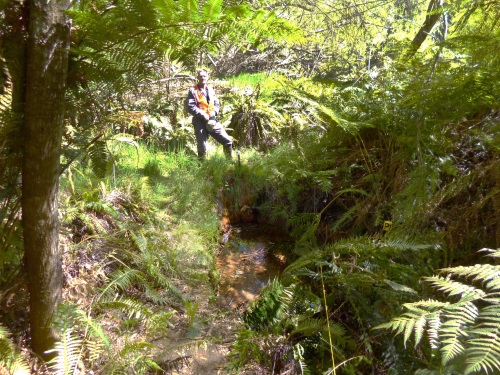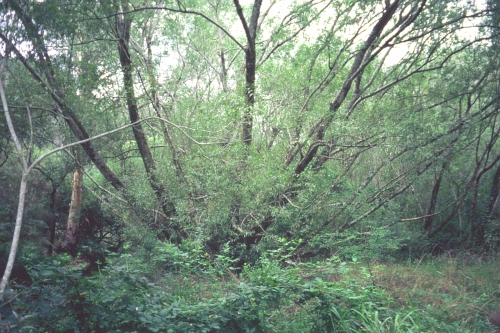Alan Lane
Key words: weed management, National Park, headwall, instability, Salix
The site: Popes Glen Creek is a small permanent stream rising in Memorial Park, Blackheath New South Wales, Australia. It flows through Popes Glen Bushland Reserve and the Greater Blue Mountains World Heritage Area (GBMWHA), joining the Grose and Hawkesbury/Nepean River systems. The upper catchment drains a significant sector of the urban township of Blackheath.
The problem: Decades of erosion from surrounding unsealed roads resulted in a 1ha silt flat forming at the headwaters of the creek and terminating in a highly incised headwall 3m high and 20m wide. Upstream, the silt flat and severely braided creek were populated by a dense forest of mature, multi-trunked specimens of Crack Willow (Salix fragilis), as well as thickets of Purple Ossier (S. purpurea), Small-leaf Privet (Ligustrum spp.), Holly (Ilex aquifolium), Cotoneaster (Cotoneaster spp.) and immature S. fragilis. There was also a ground layer of Montbretia (Crocosmia x crocosmiiflora), Blackberry (Rubus fruticosus agg), English Ivy (Hedera helix), Creeping Buttercup (Ranunculus repens) and Honeysuckle (Lonicera japonica).
This dense and complex infestation of weeds threatened to spread downstream into susceptible remote areas of the GBMWHA, where it would rapidly become extremely difficult to remove and would ultimately threaten the Grose and Hawkesbury-Nepean River systems.

Fig 2. Sept 2014 – same site nearly 10 years later, showing established plantings and some natural regeneration.
Works carried out: Phase 1: 2002 – 2008 In 2002, the Pope’s Glen volunteer bushcare group, supported by Blue Mountains City Council and funding from the Urban Run-off Control Program, established trial plantings on four sites (100m2 each) to identify a limited range of local riparian and wetland species and the planting techniques best suited to revegetating and stabilising the silt flat. The species included Red-fruit Saw-sedge (Gahnia sieberiana), three teatree species (Leptospermum lanigerum, L. polygalifolium, and L. juniperinum), Broad-leaved Hakea (Hakea dactyloides), and three ferns (Blechnum nudum, B. watsii and Cyathea australis).
A 3-year grant from the Environmental Trust (2005-2008) then enabled a program of weed removal and replanting, encompassing the upstream half of the silt flat and expanding the list of plant species to about 30.
The weeds were removed progressively in a patchwork to preserve the stability of the silt. The willows were killed by stem injection and felled when dead. Over these 3 years, the volunteer group planted approximately 7000 plants and carried out approximately 1200 hours of site maintenance. This has resulted in a diverse and resilient wetland community, with high levels of plant establishment from both planting and from natural recruitment (Figs 1 and 2).
Phase 2: 2012 – 2018 At the commencement of this phase, stability of the downstream portion of the silt flat and headwall was dependent upon the integrity of the roots of the remaining dense stands of weeds. These could be removed only as part of an integrated program of works to stabilise the silt and the headwall. A second grant from the Environmental Trust (2012-2018) is enabling an integrated, 6-year program of stabilisation, restoration and revegetation to be carried out by a team of experienced contractors, using both “soft” and “hard” engineering strategies.
The volunteer group is responsible for on-going site maintenance, photography, monitoring surface water quality and water table depth and quality, and for surveying vegetation, macro-invertebrates, frogs, birds and stygofauna.
Overall results. The formerly highly degraded silted flat is now a thriving community of wetland and riparian vegetation, home to a rich diversity of small birds, dragonflies and mayflies. Frogs are beginning to populate the site. Water quality has been significantly improved, with up to 85% of faecal coliforms and 75% of nitrate-N removed in the wetland. This improves the water quality in Popes Glen Creek and reduces the pollutant load into the GBMWHA.

Fig 3. Feb 2013 – a portion of the headwall viewed from downstream. (Plunge pool approx.3m below. (Image Damon Baker http://www.nomadgraphics.com.au).

Fig 4. Nov 2014 – same site showing heavy retaining wall and spillway now constructed. (Plunge pool has been stabilised with rock armouring.)
Lessons learned and future directions: This is an example of how an apparently overwhelming challenge can be tackled by a dedicated group of volunteers with critical mass, commitment and longevity, provided that the group has support from a body such as a local Council and that it can raise funds to employ skilled assistance as needed. It is anticipated that the ambitious program of rehabilitating the extensive and highly degraded silt flat will be completed within the life of the present grant.
Stakeholders and funding bodies: This work is supported by a grant from the Government of New South Wales through its Environmental Trust and by the Blue Mountains City Council. Unless otherwise stated, photographs have been provided by Alan Lane and Paul Vale.
Contacts: Dr Alan Lane, Coordinator Popes Glen Bushcare Group, PO Box 388, Blackheath NSW 2785, Australia. Ph +61 2 4787 7097; Paul Vale, Deputy Coordinator Popes Glen Bushcare Group, 81 Prince Edward St, Blackheath NSW 2785, Australia. Ph +61 2 4787 8080; and Ray Richardson, Chairman of Steering Committee, Environmental Trust Grant 2011/CBR/0098. Ph +61 2 4759 2534.





